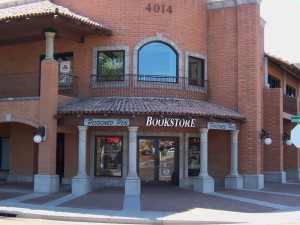Writer's Grove
The Economics of Tours 2
This is a much-delayed and overdue companion piece to the post I did back in November called The Economics of Tours. That first post spoke of why it’s not so easy for an author or a publisher to set up big sprawling tours—it costs a lot of money to travel, basically, and not enough people show up and buy books to justify the expense.
But hiding on the other side of that coin are the bookstores where events are to be held. Holding a signing is not without its own set of economic risks and headaches. And again, since most people are probably unaware, I’m sharing some basic math in the interest of being helpful, to foster understanding of why a bookstore might not wish to hold events sometimes, and appreciate those indie stores who go out of their way to hold lots of events every year.
Bookstores generally buy books from publishers for 60% of the cover price—or, if you want to look at it a different way, at a 40% discount. Let’s break down a paperback and a hardcover sale and eventually get around to what this means for touring and events.
Most paperbacks are $7.99, unless you have one of those slightly larger ones that are $9.99 and annoying to hold, but let’s go with the $8 example. On an eight-dollar book, the bookstore “keeps” $3.20. That’s if it doesn’t give you a discount or a coupon or anything.
On a $25 hardcover—and I know hardcovers vary somewhat in price, but the math is super easy at $25 so let’s just go with it—the bookstore keeps $10 if it doesn’t discount.
So right there, without going any further, you can see that any rational business person would prefer to sell hardcovers to paperbacks because they make almost three times as much money per unit. To put it another way, a bookstore has to sell three paperbacks to equal one hardcover sale. That has a profound impact on signing events.
Depending on the author, the book, the day of the week, the time of the event, and even the weather, signings tend to draw anywhere from one person to a hundred. Really big authors will draw more, of course—they’ll have seven-hour lines and maybe bathe in Courvoisier afterward—but most signings draw fewer than a hundred people in a big city. Seriously. Plenty of signings are below fifty.
Let us, however, for the sake o’ easy math, say we sell fifty books at each signing. A bookstore would make $160 if those were paperbacks, and $500 if those were the aforementioned $25 hardcovers—provided they haven’t discounted anything. But wait! They don’t actually get to keep all that!
Say you have two employees in the store. Just two. The event lasts two hours, often three, and sometimes the events go past closing time so it’s not like we’re always talking normal business hours here. The employees are paid, what, I don’t know, maybe $10 an hour? I’m afraid to ask, and I wouldn’t be surprised if it was more or less, honestly, and there are taxes and health insurance and OMG, but I’m trying to keep this simple. So two employees at $30 for three hours eats up $60 of that money. Then there’s the overhead for the bricks and mortar—lights and computers and things. And sweet deity of your choice, they pay credit card companies 8-10% per transaction! And they have marketing costs to advertise the event—signage and newsletters to subscribers and website gurus to do webby things and all the goodies they have to do to coax fifty people in a metro area of one or two million to show up. Thus, if you’re a paperback author selling fifty copies and only bringing in $160 minus a buttload of expenses for the bookstore—even less if they give the customers any kind of discount—there is so little margin there that it’s hardly worth the time and effort to do all that. In fact, there’s a very real risk that the bookstore will LOSE MONEY on the event if the turnout is low, and as I hope I have intimated clearly, turnout is often low. Or you’ll have 75 people show up but only 40 copies get sold because 35 people inexplicably believe it’s polite to show up and not buy anything—they’ll bring in copies they bought elsewhere and contribute absolutely nothing to the local store that has gone to the trouble and expense of hosting the author.
 I know my math is very basic and the devil’s in the details, and I know some indie stores have figured out how to do events well and come out ahead. They build massive mailing lists and do a ton of events and become a vibrant part of the city’s culture. The Poisoned Pen, for example, my local store, does more than 300 events a year. But many stores—especially in smaller cities without a giant mailing list—can’t shoulder the risk of a paperback event and have to turn some authors away. (Yes, even ones that sell pretty well.) And the vast number of indie bookstores that have closed over the past decade demonstrates that figuring out how to do events well (or how to sell paper books, period) is easier said than done.
I know my math is very basic and the devil’s in the details, and I know some indie stores have figured out how to do events well and come out ahead. They build massive mailing lists and do a ton of events and become a vibrant part of the city’s culture. The Poisoned Pen, for example, my local store, does more than 300 events a year. But many stores—especially in smaller cities without a giant mailing list—can’t shoulder the risk of a paperback event and have to turn some authors away. (Yes, even ones that sell pretty well.) And the vast number of indie bookstores that have closed over the past decade demonstrates that figuring out how to do events well (or how to sell paper books, period) is easier said than done.
With hardcover numbers, of course, there’s much more room for error. And that’s why bookstores would vastly prefer to host a hardcover author than a paperback one. At a hardcover event they can pray for a good night whereas with a paperback event they’re praying to break even.
There is probably a desperate plea in here to support your local independent bookstore—yes, please do that if you are lucky enough to have one!—but that’s not why I wrote this post. I wrote it to help people understand why it’s not so simple for me (and most authors) to come visit you wherever you are. There are not only economic limits to what authors can do but limits to what bookstores can do as well. It’s not that authors despise smaller cities or certain regions of the country or tiny island nations, and it’s not as if bookstore owners are actively trying to deny their communities access to authors. It’s that book signings are risky undertakings even in major cities, and everybody has to pay bills. In truth, the only reason you will ever see a signing by someone who isn’t a gigantic superstar is that bookstores love bringing authors and readers together. It’s never a sure thing that a signing will work out but they take the risk anyway and hope it will turn out okay. That’s why I love indies.
I am turbo grateful to the indie stores that have let me come by so far and to those who will be hosting me this summer, and super-turbo grateful to the readers who take the trouble to come out and see me and support those stores. I do wish I could see everyone—and I think most authors of a sociable bent would feel the same way—but yeah, for innumerable reasons, it’s just not possible. Like the famous eHarmony cat lady, I love my readers, I want to hug you all and I want you in a basket, so please don’t feel slighted if I (or another writer you dig) can’t make it to your neighborhood soon. We totally would if we could.

